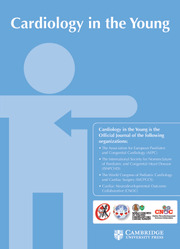To the Editor,
We read with great interest the recent case report by Sakai et al. describing the use of etilefrine in a child with refractory non-traumatic chylothorax associated with Noonan syndrome. Reference Sakai, Shiraga and Inuzuka1 The favourable clinical response to etilefrine alone after a series of conventional and surgical interventions highlights the potential utility of this pharmacological agent in difficult cases. We would like to raise several questions regarding the clinical decision-making process, particularly the indication for lymphaticovenous anastomosis (LVA), which preceded the administration of etilefrine.
First, the report did not describe in detail how the indication for LVA was determined. As LVA is typically considered for patients with identifiable lymphatic leaks or central lymphatic obstruction, it would be helpful to know whether preoperative imaging modalities, such as lymphoscintigraphy, magnetic resonance (MR) lymphography, and indocyanine green fluorescent lymphography, were performed to assess the anatomy and flow dynamics of the lymphatic system. Reference Yamamoto, Yoshimatsu, Narushima, Yamamoto, Hayashi and Koshima2-Reference Jiang, Liu, Huang, Mao and Liao5 Especially, fluorescent lymphography has been reported to be useful for evaluation of primary lymphoedema pathophysiology and selecting indications for lymphatic surgeries. Reference Yamamoto, Yoshimatsu, Narushima, Yamamoto, Hayashi and Koshima2,Reference Jiang, Liu, Huang, Mao and Liao5 Without appropriate evaluation, it is difficult to assess whether LVA was truly appropriate in this case. Second, the criteria used to judge the efficacy of LVA were not specified. Some measurements, such as near-infrared fluorescence, magnetic resonance, and ultrasonography, should have been used to determine whether the anastomosis was technically successful. Reference Yamamoto, Yoshimatsu, Narushima, Yamamoto, Hayashi and Koshima2–Reference Jiang, Liu, Huang, Mao and Liao5 In the absence of objective evaluation, it is challenging to distinguish between a failed procedure and inappropriate patient selection. Third, we were interested to know the anatomical site of the LVA performed in this case. If the anastomosis was created between the inguinal lymphatics and the femoral vein, we would question whether such a distal intervention could meaningfully reduce pressure or flow in the thoracic duct. As the pathophysiology of chylothorax often involves dysfunction near the left venous angle, procedures that do not directly address this region may have limited efficacy. In this case, as reflux from the left venous angle into the thoracic duct was observed, venous angle LVA might have been an option. Further research on which approach brings a better outcome is needed.
In this context, the patient’s eventual resolution of chylothorax with etilefrine raises the possibility that earlier pharmacologic intervention may have avoided the need for LVA altogether. Although LVA is an important option, we encourage future case reports to define more explicitly the criteria for the use of etilefrine. We commend the authors for contributing a valuable case to the growing literature on lymphatic interventions in paediatric patients and hope that future reports will help refine our understanding of when and how etilefrine and LVA should be optimally employed.
Acknowledgement
None.
Funding statement
This research received no specific grant from any funding agency, commercial or not-for-profit sectors.
Competing interests
None.
Ethical approval
Not required.


